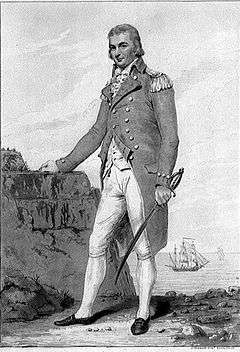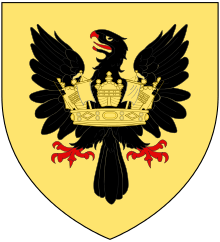William Carnegie, 7th Earl of Northesk
Admiral William Carnegie, 7th Earl of Northesk GCB (19 April 1758 – 28 May 1831) was born at Bruntsfield in Edinburgh to Admiral George Carnegie, 6th Earl of Northesk and Anne Melville.[1]
The Earl of Northesk | |
|---|---|
%2C_Thomas_Phillips.jpg) William Carnegie, 7th Earl of Northesk | |
| Born | 19 April 1758 Bruntsfield, Edinburgh, Scotland |
| Died | 28 May 1831 (aged 73) Westminster, England |
| Allegiance | |
| Service/ | |
| Rank | Admiral |
| Commands held | Plymouth Command |
| Battles/wars | American War of Independence French Revolutionary War Napoleonic Wars |
| Awards | Knight Commander of the Order of the Bath Knight Grand Cross of the Royal Guelphic Order |
Naval career
Early career
Following his father into the navy in 1771, Carnegie served in the American War of Independence[2] on the frigate HMS Beaulieu and the ship of the line HMS Sandwich, being involved in the Battle of Martinique in 1780 under Admiral Rodney. His good conduct during the engagement was recognised by Rodney, who promoted Carnegie to commander[3] and then aided his rise to Post captain in 1782, whereupon he was given command of the frigate HMS Enterprise.
Ten years later at the outbreak of the French Revolutionary War, on 22 January 1792, Carnegie had acceded to the earldom and became the Earl of Northesk. He was given a new ship of the line HMS Monmouth to command in 1796 and having as his first lieutenant Charles Bullen, the start of an excellent professional partnership and close personal friendship. The following year he was caught up in the Nore mutiny but was released by the mutineers to take their demands to London. Like many in the fleet, Northesk had some sympathy with the initial stages of the mutiny, and so when the demands were refused, he resigned his position as untenable following his failure to restore order on his ship or gain concessions from the government.

of 3 year seniority
Reinstated by the Admiralty in 1803[4] with full seniority as a rear-admiral, Northesk was given the 100 gun first rate HMS Britannia as his flagship, and after a brief period in the Channel Fleet, was sent south with Sir Robert Calder to join the blockading squadrons off Spain. With him went Captain Bullen. He missed the Calder's action in 1805, and joined Nelson's fleet off Cadiz that same year.
Battle of Trafalgar
As the inevitable Battle off Cape Trafalgar came closer, Northesk was largely left out of the planning of the encounter, partly because he was the third most senior admiral present behind Nelson and Collingwood and partly because unlike most of the captains at the battle, Northesk had never worked with Nelson before and was not a member of the famous Band of Brothers.
Nonetheless, when battle came Northesk was ready and although his slow ship took some time to reach the fighting, he was heavily engaged with the enormous Spanish 130 gun ship Santissima Trinidad, the Britannia suffering 52 casualties[5] in the battle. He was greatly rewarded for his service in action, but like many Trafalgar captains, never served at sea again as sufficiently senior posts could not be found abroad. He was however initiated into the Order of the Bath, eventually reaching the position of Knight Grand Cross. He also reached the rank of full admiral, the ceremonial post of Rear-Admiral of Great Britain and was made Commander-in-Chief, Plymouth[6] later in his career.
Death
He died in 1831 in London[7] and was buried alongside Nelson and Collingwood in the crypt at St Paul's Cathedral, where his tomb can still be seen.
Finance Career
British Linen Company
Northesk was instated as the Governor of the British Linen Company from 1800 to his death in 1831. The Company held an important history in the economic development of Scotland, as it stimulated industrial investment in the production of linen and spinning factories across the rural Highlands and the East Coast. By the nineteenth century, the Company had undergone a full transformation from a manufacturing company into a Bank and it stood alongside the great institutions of the Bank of Scotland and the Royal Bank of Scotland in Edinburgh.[8]
Family
He married Mary Ricketts, daughter of William Henry Ricketts, on 9 December 1788 and had nine children:

- Mary Carnegie (3 October 1789–7 March 1875) married Walter Long of Preshaw in 1810
- George Carnegie, Lord Rosehill (c. 1790 – February 1807), lost in HMS Blenheim
- William Hopetoun Carnegie, 8th Earl of Northesk (6 October 1794–5 December 1878)
- Anne Letitia Carnegie (c. 1796–25 February 1870)
- Elizabeth Margaret Carnegie (c. 1798–12 April 1886) married General Frederick Rennell Thackeray in 1825 and had eight children[9]
- Jane Christian Carnegie (c. 1800–1 October 1840)
- John Jervis Carnegie (8 July 1807–18 January 1892)
- Georgina Henrietta Carnegie (2 August 1811–7 November 1827)
- Admiral Swynfen Thomas Carnegie (8 March 1813–20 November 1879)
References
- Trafalgar order of battle
- "William Carnegie, Earl of Northesk". Family Search: Community Trees. The Church of Jesus Christ of Latter-day Saints. Retrieved 21 November 2012.
- Promoted Lieutenant in 1777
- 1781
- 23 April 1803
- 10 killed 42 wounded
- 1827-1830
- Albemarle Street, Piccadilly, London.
- Malcolm, Charles A (1950). The History of the British Linen Bank. Edinburgh. p. 202.
- Wikisource:Thackeray, Frederick Rennell (DNB00)
Further reading
- The Trafalgar Captains, Colin White and the 1805 Club, Chatham Publishing, London, 2005, ISBN 1-86176-247-X
External links
| Wikimedia Commons has media related to William Carnegie (1758-1831). |
| Military offices | ||
|---|---|---|
| Preceded by Sir James Saumarez |
Commander-in-Chief, Plymouth 1827–1830 |
Succeeded by Sir Manley Dixon |
| Honorary titles | ||
| Preceded by Sir James Saumarez |
Rear-Admiral of the United Kingdom 1821–1831 |
Succeeded by Sir Thomas Foley |
| Peerage of Scotland | ||
| Preceded by George Carnegie |
Earl of Northesk 1792–1831 |
Succeeded by William Carnegie |